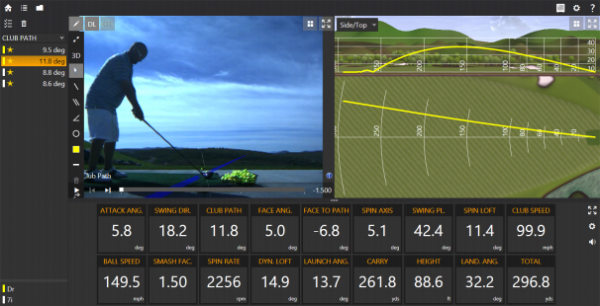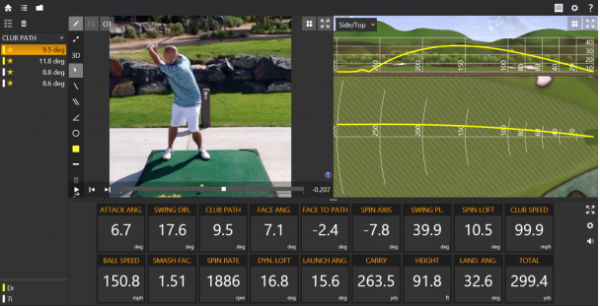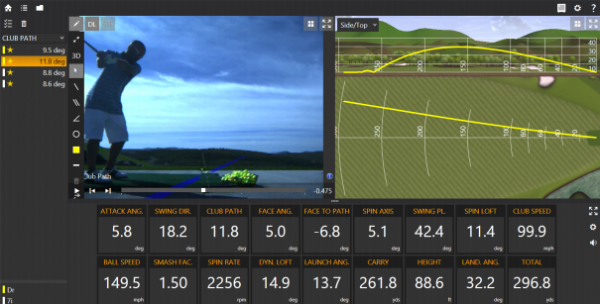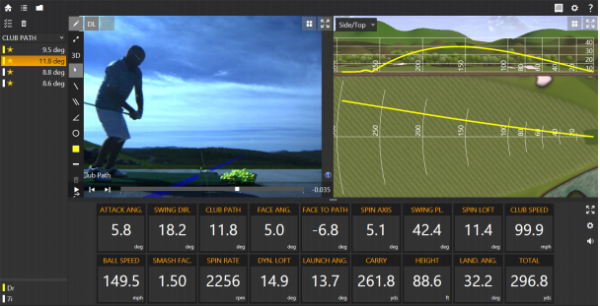Instruction
Stickney: Fix the real cause of the problem with a launch monitor

As teachers, we all have our own ideas of how golfers should swing the club. Sometimes our recommendations for a particular student follow the norm while other times they can be a little different because of an injury or some other kind of irregularity.
In a perfect world, after you made a few swings in front of us teachers, we would be able to see the end result of what you can do based on our experience, your coordination, your time to practice, your desire, etc. From there, we could make our own best guess as to how to get you playing your best in the shortest amount of time. While improving someone’s golf game never has been and probably never will be a perfect science, the inventions of high-speed video, 3D Motion Analysis software and Doppler Radar launch monitors like FlightScope and Trackman, it has never been easier to see what players can and cannot do fundamentally.
Sometimes teachers can make things too hard for their students and at times we can get off-track if we go too fast during a lesson. I am just as guilty as any of the teachers you know; it can be tough sometimes because we see so many people. The bottom line is that there is a cause for everything in the golf swing, and through lessons we hope to improve whatever effect is holding you back from the results you want.
I would like to show you a swing sequence from a buddy of mine; a former mini-tour guy who is a total feel player (if you don’t know what that means, think Fred Couples). He’s proof that it’s often a good idea for instructors to put their technology to use on a student before they jump into quick fixes that could actually be a disservice.
Here you will see that as a teacher you must sometimes use your technology in a way that slows you down. You cannot always jump into fixing all the effects you see right away or you can create new problems without fixing the old ones.
Photo 1
You can see that this player had a swing path that was moving 11.8 degrees from in to out, which was obviously an issue. The key for me, however, was to understand why is the path was moving so rightward. It would have been easy for me to tell him to feel like he was hitting over-the-top cuts and that would have fixed the path. But without knowing the real cause of the in-to-out path, I couldn’t be sure that was the best way to help him.
Photo 2
Look at the front angle of his swing (Photo 2) and you might notice a reverse hip shift. His right leg is angled inward, his left knee is out toward the ball and his torso is leaning over the right leg to counter balance the body. Think about it this way: As the hips run out from under this player, his left shoulder will dip down and his arms will go up. From here, the club is in an overly upright position and if he didn’t drop his club under his path would be too far to the left to hit a consistent draw.
Photo 3
Photo 3 is evidence of this. His right knee is straightening too fast in the backswing (for this player, but not all players of course) and the left knee is moving outward toward the ball. That pushes the arms out away from the body. From here, all he can do is re-route the club deeply to the inside to shift the path right of his face so he can move the ball right to left.
Photo 4
From the position in photo 4, he has pushed the swing direction so far to the right that it will be very hard for him to not hit blocks or big swinging hooks. So, the EFFECT was an overly in-to-out path that was causing an inconsistent ball flight, but the CAUSE was his faulty pivot motion (the reverse hip shift) that pushed the club into a position at the top that necessitated an overly aggressive drop to the inside in order to hit draws.
How did we fix it? It was simple.
I told him to let his shoulders lead. They would power the backswing, PULLING the hips to the top. This slowed down the rate of the hip rotation and the reverse hip shift went away.
With a better pivot, the arms weren’t pushed away from the body and the shoulders turned a touch more perpendicular to the axis of the spine to the top. That rounded out his backswing a touch and cured his need to re-route the club so deeply during the downswing. Remember, for better players and feel players, if you can put them into a better fundamental position at the top, the downswing usually will improve. Fix the cause, not the effect!
This was all the more evidence that if teachers are too fast with their diagnosis they can miss the boat on the simple fixes that bring rampant improvement. I always try NOT to go off on a complex mechanical tangent unless it is necessary. Usually, fixing the things that happen earlier in the swing will greatly influence the things that happen later. That’s why teachers should always think twice (and maybe a few more times) before they act, and modern technologies like FlightScope and Trackman are great resources to consult if there is any uncertainty or for a second opinion.
- LIKE4
- LEGIT1
- WOW0
- LOL0
- IDHT0
- FLOP0
- OB0
- SHANK0
Instruction
Clement: Laid-off or perfect fade? Across-the-line or perfect draw?

Some call the image on the left laid off, but if you are hitting a fade, this could be a perfect backswing for it! Same for across the line for a draw! Stop racking your brain with perceived mistakes and simply match backswing to shot shape!
- LIKE0
- LEGIT0
- WOW0
- LOL0
- IDHT0
- FLOP0
- OB0
- SHANK0
Instruction
The Wedge Guy: The easiest-to-learn golf basic

My golf learning began with this simple fact – if you don’t have a fundamentally sound hold on the golf club, it is practically impossible for your body to execute a fundamentally sound golf swing. I’m still a big believer that the golf swing is much easier to execute if you begin with the proper hold on the club.
As you might imagine, I come into contact with hundreds of golfers of all skill levels. And it is very rare to see a good player with a bad hold on the golf club. There are some exceptions, for sure, but they are very few and very far between, and they typically have beat so many balls with their poor grip that they’ve found a way to work around it.
The reality of biophysics is that the body moves only in certain ways – and the particulars of the way you hold the golf club can totally prevent a sound swing motion that allows the club to release properly through the impact zone. The wonderful thing is that anyone can learn how to put a fundamentally sound hold on the golf club, and you can practice it anywhere your hands are not otherwise engaged, like watching TV or just sitting and relaxing.
Whether you prefer an overlap, interlock or full-finger (not baseball!) grip on the club, the same fundamentals apply. Here are the major grip faults I see most often, in the order of the frequency:
Mis-aligned hands
By this I mean that the palms of the two hands are not parallel to each other. Too many golfers have a weak left hand and strong right, or vice versa. The easiest way to learn how to hold the club with your palms aligned properly is to grip a plain wooden ruler or yardstick. It forces the hands to align properly and shows you how that feels. If you grip and re-grip a yardstick several times, then grip a club, you’ll see that the learning curve is almost immediate.
The position of the grip in the upper/left hand
I also observe many golfers who have the butt of the grip too far into the heel pad of the upper hand (the left hand for right-handed players). It’s amazing how much easier it is to release the club through the ball if even 1/4-1/2″ of the butt is beyond the left heel pad. Try this yourself to see what I mean. Swing the club freely with just your left hand and notice the difference in its release from when you hold it at the end of the grip, versus gripping down even a half inch.
To help you really understand how this works, go to the range and hit shots with your five-iron gripped down a full inch to make the club the same length as your seven-iron. You will probably see an amazing shot shape difference, and likely not see as much distance loss as you would expect.
Too much lower (right) hand on the club
It seems like almost all golfers of 8-10 handicap or higher have the club too far into the palm of the lower hand, because that feels “good” if you are trying to control the path of the clubhead to the ball. But the golf swing is not an effort to hit at the ball – it is a swing of the club. The proper hold on the club has the grip underneath the pad at the base of the fingers. This will likely feel “weak” to you — like you cannot control the club like that. EXACTLY. You should not be trying to control the club with your lower/master hand.
Gripping too tightly
Nearly all golfers hold the club too tightly, which tenses up the forearms and prevents a proper release of the club through impact. In order for the club to move back and through properly, you must feel that the club is controlled by the last three fingers of the upper hand, and the middle two fingers of the lower hand. If you engage your thumbs and forefingers in “holding” the club, the result will almost always be a grip that is too tight. Try this for yourself. Hold the club in your upper hand only, and squeeze firmly with just the last three fingers, with the forefinger and thumb off the club entirely. You have good control, but your forearms are not tense. Then begin to squeeze down with your thumb and forefinger and observe the tensing of the entire forearm. This is the way we are made, so the key to preventing tenseness in the arms is to hold the club very lightly with the “pinchers” — the thumbs and forefingers.
So, those are what I believe are the four fundamentals of a good grip. Anyone can learn them in their home or office very quickly. There is no easier way to improve your ball striking consistency and add distance than giving more attention to the way you hold the golf club.
More from the Wedge Guy
- The Wedge Guy: Golf mastery begins with your wedge game
- The Wedge Guy: Why golf is 20 times harder than brain surgery
- The Wedge Guy: Musings on the golf ball rollback
- LIKE86
- LEGIT13
- WOW6
- LOL1
- IDHT0
- FLOP4
- OB1
- SHANK8
Instruction
Clement: Stop ripping off your swing with this drill!

Not the dreaded headcover under the armpit drill! As if your body is defective and can’t function by itself! Have you seen how incredible the human machine is with all the incredible feats of agility all kinds of athletes are accomplishing? You think your body is so defective (the good Lord is laughing his head off at you) that it needs a headcover tucked under the armpit so you can swing like T-Rex?
- LIKE0
- LEGIT2
- WOW2
- LOL0
- IDHT0
- FLOP0
- OB0
- SHANK2
-

 19th Hole2 weeks ago
19th Hole2 weeks agoDave Portnoy places monstrous outright bet for the 2024 Masters
-

 19th Hole3 days ago
19th Hole3 days agoJustin Thomas on the equipment choice of Scottie Scheffler that he thinks is ‘weird’
-

 19th Hole2 weeks ago
19th Hole2 weeks agoTiger Woods arrives at 2024 Masters equipped with a putter that may surprise you
-

 19th Hole3 days ago
19th Hole3 days ago‘Absolutely crazy’ – Major champ lays into Patrick Cantlay over his decision on final hole of RBC Heritage
-

 19th Hole3 weeks ago
19th Hole3 weeks agoReport: Tiger Woods has ‘eliminated sex’ in preparation for the 2024 Masters
-

 19th Hole1 week ago
19th Hole1 week agoTwo star names reportedly blanked Jon Rahm all week at the Masters
-

 19th Hole1 week ago
19th Hole1 week agoReport: LIV Golf identifies latest star name they hope to sign to breakaway tour
-

 19th Hole1 week ago
19th Hole1 week agoNeal Shipley presser ends in awkward fashion after reporter claims Tiger handed him note on 8th fairway



















scientific golfer
Dec 29, 2014 at 8:05 pm
While killing time in the gym at my home course during a frost delay I was getting in my setup and doing practice swings with a medicine ball while looking in the mirror (something I do often when waiting to tee off, or while waiting for the range to open). I noticed I too had over active knee, leg, and hip movement (at least in my mind). Unlike your student I didn’t use shoulder motion as a fix. I went lower down for my fix, and decided to isolate the leg movement directly. I already balance over my ankles, and inside of my feet (to stabilize myself and maintain posture during the swing). While I could think about holding a knee in position its hard to do that with both at the same time. What I need up doing was using a key Ernie Els wrote about in the wedge section of his short game book. I went with the feeling of having pressure down into my legs which activated muscles in the legs to stabilize and reduce motion. Ernie discribed it as how an Olympic weight lifter rests the barbell on the legs before slinging it up for the lift. I believe some people like to call the act ground force resistance. Getting back to its effect on the golf swing it quieted my lower body (knees, legs, and hips), lead to a shorter swing that kept my arms more in front of my chest near the top of the swing, and made my transition and downswing more automatic. I also think more efficient with less moving parts, and less area to go wrong. Its an alternative you might want to consider if you see the problem occur again (unless you see a problem with this solution).
Robert
Sep 13, 2014 at 11:47 pm
I learned a long time ago that having the proper grip and posture makes it so much easier to hit the ball well. If anyone goes to a lesson and the teacher does not start with your grip, then leave immediately. It is incredibly hard to succeed without a proper grip and stance. I worked on just those two things for months and it did wonders for my golf game and I’ve helped plenty of people by telling them to do the same. Your chances of hitting it well increase so much by having proper fundamentals.
Tom Stickney II
Sep 14, 2014 at 12:39 am
Setup is key
Anon
Sep 10, 2014 at 12:38 am
I have never seen a 1.50 smash factor before, much less a 1.51! That’s incredible! Is that clubhead speed measurement accurate at 99 mph?
Tom Stickney II
Sep 10, 2014 at 1:18 am
Yep…he’s a great ball striker
TP
Sep 9, 2014 at 11:18 pm
Hi Tom, really enjoy your work.
Just a question, with photo 2 the face to path was -2.4 and the flight showed a slight draw however with photos 1, 3 and 4 the face to path was -6.8 however the ball shaped left to right.
Just wondering why?
Thanks
Tom Stickney II
Sep 10, 2014 at 1:20 am
Two different swings. If you see a face to path with an opposite spun axis there is gear effect from off center hits
Ross
Sep 10, 2014 at 1:03 pm
So not such a great ball-striker after all?
Tom Stickney II
Sep 10, 2014 at 3:21 pm
Better than most
Tom Duckworth
Sep 9, 2014 at 7:07 pm
Thanks this story really helped me. Lately I have been trying to focus on posture and I think I have been having somewhat the same issue with my lower body. So you gave me something to think about my next range session. Lets the shoulders turn correctly with good posture and the hips should take of themselves.
Tom Stickney II
Sep 9, 2014 at 7:51 pm
delayed hip action per homer kelley is a good way to play.
CD
Sep 10, 2014 at 3:12 am
Your point about launch monitors and looking at causation is fine, but you whilst you fixed his ball flight the tips of his vertebrae will now be clanging together and calcifying over time (arthritis) if the player attempts to turn his thoracic spine before the lumbar section. His initial hip pivot looked sound, more in unison and there appeared to be a transfer of weight. I don’t disagree that a chain of causation for the in to out path might lead to the hip motion, but better ball flight and natural ranges of motion are not necessarily mutual. The next link up in the chain might sometimes be the one to fix and not the base?
steve ball
Sep 10, 2014 at 3:07 pm
exellent comments — sounds like the fantastic information the golf world is learning from the guys at TPI. Evals first then the swing
Tom Stickney II
Sep 10, 2014 at 3:24 pm
What if he doesn’t or won’t work out? What then?
Tom Stickney II
Sep 10, 2014 at 3:23 pm
I disagree
Tom Stickney II
Sep 10, 2014 at 3:28 pm
I disagree…I have an exercise science degree so I’m familiar with the pelvic actions you’re discussing thus my opinions.
KB33
Sep 9, 2014 at 2:36 pm
YES, thank you! More socialization of this type of instruction is beyond important.
Tom Stickney II
Sep 9, 2014 at 3:02 pm
Glad you liked it.
Doc Todd
Sep 9, 2014 at 12:48 pm
I wish there was a local place in OKC that had this technology! If these radars weren’t so expensive, I’d look t one for personal use.
TR1PTIK
Sep 9, 2014 at 2:40 pm
I’m sure you could find a pro who has one in your area. I didn’t think I’d find any in JOMO, but one of the local course pros bought a Flightscope this season to use during lessons. I have an appointment on Friday.
Tom Stickney II
Sep 9, 2014 at 3:00 pm
Let me know how it goes!
Tom Stickney II
Sep 9, 2014 at 3:02 pm
Oaktree has one
Doc Todd
Sep 9, 2014 at 5:14 pm
Thanks Tom, I will check them out and see if they will do lessons for non members or reciprocate fees.
Tom Stickney II
Sep 9, 2014 at 5:42 pm
Anytime
steve ball
Sep 10, 2014 at 3:06 pm
Doc,
this is steve ball from ball golf center. we have this trackman technology that is displayed here. We are also Level 3 TPI fitness which means we can discuss the comment from above about stacked vetebrae, T spin rotation… which is really the cause of this players problem, I believe. Until that is addressed it is hard to make swing changes. Call if you would like to discuss
steve ball 842-2626
Tom Stickney II
Sep 10, 2014 at 3:25 pm
Let me know what you two come up with. I’ll pass it on.
Don
Sep 9, 2014 at 11:01 am
Thank you Tom for bringing this to light. I have gone through a couple of instructors whom I think were more focused on fixing the effect as you say. My instructor now really took some time to look at my swing and my ball striking improved significantly. Ironically it was a similar issue to your example.
Tom Stickney II
Sep 9, 2014 at 11:35 am
Awesome. Thx
NT
Sep 9, 2014 at 10:24 am
Great Article!
Tom Stickney II
Sep 9, 2014 at 10:26 am
Thx.